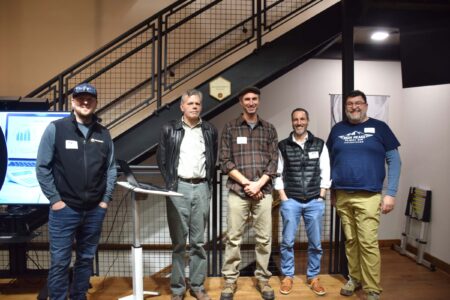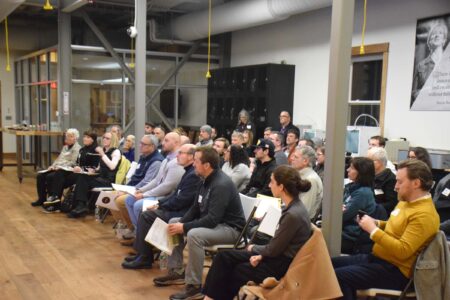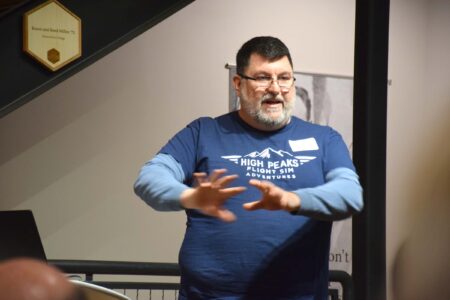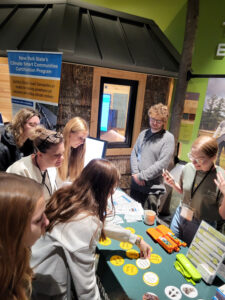Pitching potential
Five finalists share early-stage business ideas to bolster Adirondacks’ economy
- The five finalists of A2I’s Adirondack Launch Pad are seen in the Northwood School’s Innovation Hub in Lake Placid on Thursday evening. From left are Tim Jackson, James C. Dewey, Greg Simkiss, Chip Pulitzer and Edward M. Alford. (Enterprise photo — Chris Gaige)
- A2I Director Svetlana Filipson and Adirondack Community Foundation Trustee Craig Weatherup are seen in the Northwood School’s Innovation Hub in Lake Placid on Thursday evening. (Enterprise photo — Chris Gaige)
- An audience of about 40 listens to a pitch at the Adirondack Launch Pad, held at the Northwood School’s Innovation Hub in Lake Placid on Thursday evening. (Enterprise photo — Chris Gaige)
- Adirondack Launch Pad runner-up Edward M. Alford pitches his start-up idea for the High Peaks Flight Simulator Center at the Northwood School’s Innovation Hub in Lake Placid on Thursday evening. (Enterprise photo — Chris Gaige)

The five finalists of A2I’s Adirondack Launch Pad are seen in the Northwood School’s Innovation Hub in Lake Placid on Thursday evening. From left are Tim Jackson, James C. Dewey, Greg Simkiss, Chip Pulitzer and Edward M. Alford. (Enterprise photo — Chris Gaige)
LAKE PLACID — Where does economic growth come from? Labor, capital and good public policy are all pieces of the puzzle, to be sure. Undepinning all of those factors, however, is simply a good idea.
But turning a good idea into a successful business is much easier said than done — although it’s something the Adirondack Community Foundation is committed to fostering at the local level through its Adirondack Innovation Initiative (A2I).
A2I held its first-ever Adirondack Launch Pad on Thursday at the Northwood School’s Innovation Hub in Lake Placid. The pitch session featured five budding entrepreneurs drawn from a field of 38 project submissions. The finalists were selected based on the future ability to drive quality job growth in the Adirondacks, through the ventures’ scalability, market potential and regional impact.
The finalists included:
¯ James C. Dewey: A chimney fire impression system that detects and extinguishes chimney fires by automatically deploying a stored fire retardant.

A2I Director Svetlana Filipson and Adirondack Community Foundation Trustee Craig Weatherup are seen in the Northwood School’s Innovation Hub in Lake Placid on Thursday evening. (Enterprise photo — Chris Gaige)
¯ Edward M. Alford (Runner-up): High Peaks Flight Simulator Center: A multi-purpose tourism, educational and training center offering fully-immersive flight simulators — with potential aircraft models including an Airbus A320 and a Cessna-model propeller plane — along with several computer simulators, potentially augmented with virtual reality headsets.
¯ Chip Pulitzer: An onshore data pipeline company located in the Adirondacks focused on building, maintaining and securing customized data infrastructure for clients.
¯ Greg Simkiss (Winner): ADK Modular Building Materials: An Adirondacks-based modular home construction plant designed to address the regional housing shortage by rapidly and affordably creating components for low-cost, but well-engineered and built homes.
¯ Tim Jackson: A non-profit shared space for tradespeople and local makers, offering a dedicated work and training space that would consolidate and reduce various fixed costs, such as tools and utility costs of a shared workspace.
Each competitor had 10 minutes to make their pitch and answer the judges’ questions. Though there were financial rewards — $100 for the finalists, $500 for the runner-up and $1,000 for the winner — the real prize for having made it this far was the access to ongoing mentorship and connections through A2I and Clarkson University’s Innovation Corps (I-Corps) Program.
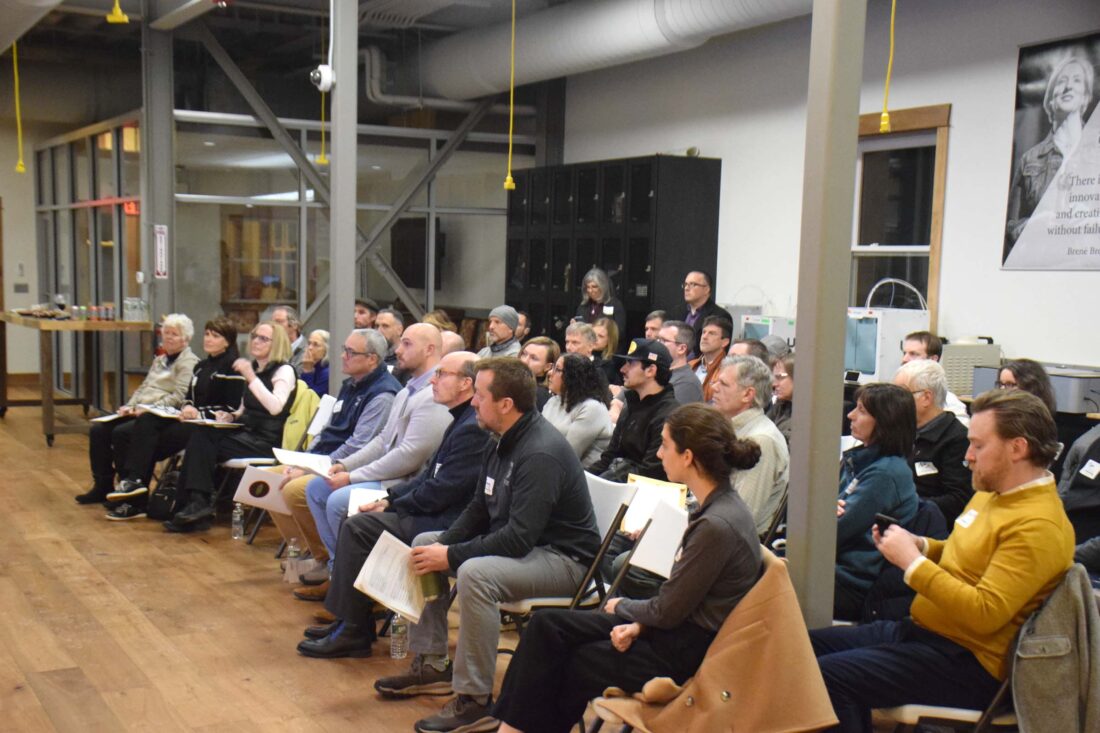
An audience of about 40 listens to a pitch at the Adirondack Launch Pad, held at the Northwood School’s Innovation Hub in Lake Placid on Thursday evening. (Enterprise photo — Chris Gaige)
Adirondack Community Foundation Trustee Craig Weatherup had the initial vision behind the event. He credited A2I Director Svetlana Filipson for running with the idea and turning it into reality.
Filipson said receiving 38 project ideas exceeded her expectations, and said getting it down to the five finalists made for many hard decisions.
“Everyone came really prepared, and you could tell that their hearts and souls went into it,” she said. “We really hope that they pursue these business ideas.”
–
Dewey
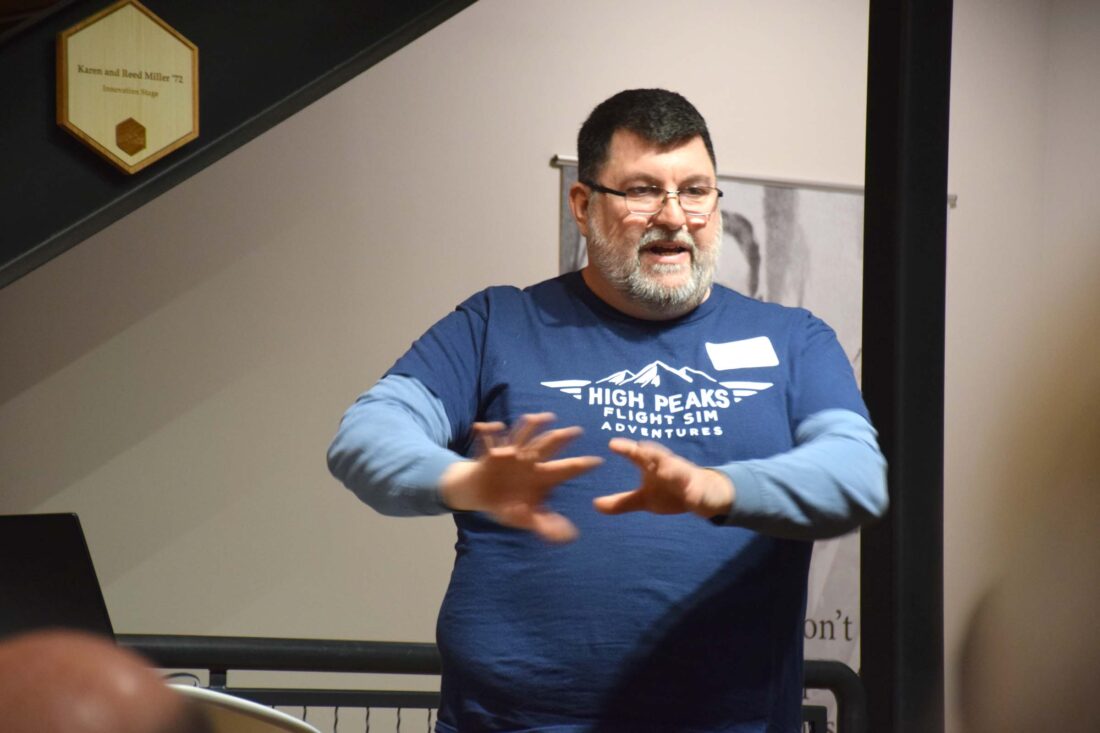
Adirondack Launch Pad runner-up Edward M. Alford pitches his start-up idea for the High Peaks Flight Simulator Center at the Northwood School’s Innovation Hub in Lake Placid on Thursday evening. (Enterprise photo — Chris Gaige)
–
Dewey moved to the North Country in 2010, when he began using wood to supplement his home heating. That’s when he became aware of the added risks from burning wood, such as chimney fires, as well the often prolonged response times — a reality of living in a rural area, where fires can break out far away from the nearest station.
“After some rumination on this issue, I came up with an idea to develop a chimney fire suppression system,” he said. “My idea is to use a thermocouple sensor to detect elevated temperatures in the flue, inject (carbon dioxide), close the top of the flue to confine the CO2, trigger an alarm in the dwelling and notify the fire department to respond and confirm that the danger has been contained.”
Carbon dioxide is heavier than oxygen — the gas that sustains combustion — and thus is able to displace it. CO2 also cools the fuel source as it expands from its previous high-pressure storage chamber.
Dewey said he developed the idea initially about 10 years ago, but put it on the back burner. Then, he saw A2I’s Adirondack Launch Pad as an opportunity to renew the push for its development.
“In my former life as a design engineer, I had experience in product development, design controls, writing patents and successful product launches in the medical industry,” he said. “At this point in my life, I have put aside aspirations of any sort of windfall profit for myself. I’d rather share this idea, see it come to life and be part of something meaningful — because it does no good to be locked up in my head, never to be realized.”
Dewey added that if the system were to be successfully invented and put on the market, he’d want to see it be priced affordably, and for its installation to be incentivized through home insurance discounts.
“Recent statistics provided by the National Fire Prevention Association claim there are 25,000 chimney fires in the U.S. that account for millions of dollars in losses, as well as injuries and deaths,” he noted.
Important resources that he lacks at this point in development include expert input and design feedback from fire prevention specialists, as well as legal consultation — for both patent and liability expertise — which he acknowledged would likely be costly with a product so integral to safety.
Dewey also said his idea needs input from an electromechanical engineer to effectively program the system and help from sales experts to refine the marketing angle.
Dewey concluded his pitch by pointing to the economic benefits that the idea could bring if it’s successfully realized and delivered at scale.
“It could result in job creation from people manufacturing the product, installing the product and servicing it at regular intervals,” he said. “As well as providing an important component of safety that rural homes rely on with urgent need.”
–
Alford
–
Alford has had a passion for aviation since he was about 7 years old. At age 14, it became his first job. He rode his bike down to the Lake Placid Airport and was hired by Adirondack Flying Service, run at the time by Steve Short. Alford currently serves as the Adirondack Regional Airport’s assistant manager, has been an airline safety manager and is a Federal Aviation Administration-licensed dispatcher.
Alford has business experience in both aviation — including hiring, scheduling, budgeting and handling human resource-related matters — as well as outside of the field. He’s previously managed teams of up to 12 people in the restaurant and hotel industries.
Alford is vested in the region. His family has lived in Lake Placid for five generations, going back to the 1860s.
“My family’s had multiple businesses along Main Street over the last century and a half, so I have a kind of deeper desire to bring a continued business to Lake Placid,” he said.
Alford has had the idea of a flight simulator tourism, education and training center floating in his head for about the last 25 years. He saw the Adirondack Launch Pad as an opportunity to take it one step closer to reality.
“Here in Lake Placid, we want to fill a gap,” he said. “What we have is a lack of year-round STEM-focused high-value indoor attractions for all ages. And one thing that will do that is a full flight simulator. So, imagine an airliner cockpit and a STEM education lab right here on Main Street in Lake Placid.”
The true-size, full-immersion cockpits would come with all the actual control panels, sensors, lights and full-size “windows” — with high-resolution computer monitors that would simulate flight trajectories based on control input. Alford said it’d be a stationary cockpit, as opposed to more expensive simulators that move and pivot.
Still, though, he said the computer screens are so responsive and accurate that people feel like it’s in motion — complete with butterflies in their stomachs.
Alford said that while the commercial/tourism aspect would be crucial to its business viability, a large focus would be on education. Given the lack of nearby major airports, Alford said local students don’t have that many opportunities to be exposed to the career fields in education, especially the wide array that exists beyond the “high visibility” roles — what people commonly think of, such as pilots, flight attendants and air traffic controllers — but are nonetheless critical to making an aircraft run.
Alford noted that since he first formed the idea, flight simulators have become cheaper. What would have cost well over $1 million about 15 years ago, now costs about $250,000. He would plan to sell simulator sessions for between $60 and $150. He had various revenue projections and believed it was feasible to have the gross margin break even within 18 months.
He said the business would require an approximately 2,000 square-foot space, which he acknowledged wouldn’t be easy to find.
A positive for the venture is the lack of competition. Alford only came across seven other publicly available flight simulator experiences in the U.S., all in major cities and all tending to only offer Boeing 737 simulators.
He envisioned the business adding four year-round jobs, with a fifth position potentially to assist on busy days. Alford said if things were to get off the ground, he would make running the High Peaks Flight Simulator Center his full-time job.
“This is something that I really want to bring to Lake Placid,” he said.
–
Pulitzer
–
Pulitzer admitted from the onset that data pipeline services was far from the easiest industry to explain. He walked the audience through an example: Returnalyze, one of the most successful companies in the industry. Put simply, the company uses advanced data analytics from customer feedback to determine where a clothing company, for example, could save money by reducing the amount of its merchandise that is returned.
Returnlyze might recognize that a large percentage of returns are for one particular clothing item, or line of products, because they might run larger than advertised, for example. As long as the clothing company is able to save more money than the data analytics service costs, Pulitzer said it’s a win-win and an economically viable venture.
Though it’s a relatively straightforward example, the devil is in the details. He said these sorts of data pipeline services are different than software development, the latter of which is more conducive to offshoring, as the work can be done in small, technically-specialized coding teams talking amongst themselves and are able to work through time zone and language barriers.
Data pipeline services, on the other hand, require a lot of real-time communication to fix problems immediately after they arise. It also involves communication between data experts and businesspeople who are less, or not at all, steeped in computer science. This is when time and language barriers become an issue, something that Pulitzer noted gets magnified when it’s a highly sensitive type of business, such as medical or financial records — compared to the aforementioned clothing company example.
“Using offshore people for data operations becomes really, really messy,” he said. “Language becomes an issue. When folks in Nepal are trying to talk directly with customers, it doesn’t work very well. People get impatient, nerves get frayed.”
He added that the language barrier extends beyond word-to-word translation and that contextualization issues arise.
“When you try to explain what a revenue cycle management system is, what claims adjudication is, it’s crazy,” he said.
Besides logistical nightmares, Pulitzer said overseas wages have increased significantly from even just a few years ago. It’s a rapidly changing space, and the days of paying data operations employees in even the poorest nations $5 per hour are over.
As a result, Pulitzer said many companies find themselves in a difficult spot right now, as there are not a lot of domestic data operations companies to handle the demand. On the other hand, that means market conditions are favorable for the sort of business idea Pulitzer has in mind to take off.
He explained that data operations require some relatively basic coding skills, as much of the service involves tailoring a thin surface layer of coding on top of a much more intricate and fixed base set in order to a product fit a client’s unique needs.
Pulitzer added that the target clients would be established small and medium-sized businesses that would have relatively simpler needs than the nation’s biggest companies — which aren’t in as much of a bind and already have their data operations covered, given their size and ability to sink significant resources into.
Pulitzer said these can be taught to entry-level employees without a background in coding and without specialized degrees.
“What you need are smart, motivated people who are willing to learn,” he said. “People who are basically willing to work fairly low wages for a couple of years in exchange for software training. So the goal, of course, is that they eventually learn enough that they could pass a coding test and do well in an interview and are essentially going to graduate from this business and they’re going to land a job with Meta, or a Google. Maybe they leave, maybe they stay, maybe they start their own business.”
In addition to these positions, Pulitzer said his business idea would provide two “instructor” positions that would train in-house. Given the technical expertise these positions would demand, they would be relatively high-salaried positions.
The beauty of the idea, Pulitzer noted, was that it could be done in the Adirondacks. The coding would require a “modest” internet connection, but nothing beyond what’s already widespread in the Adirondacks’ more densely populated villages and hamlets.
–
Simkiss
–
Simkiss presented on creating an affordable modular home building business in the Adirondacks, driven by a desire to help fix the housing affordability crisis, which he said was largely driven by supply-side constraints.
Modular homes are not mobile homes. Instead, they’re largely prebuilt at a centralized indoor location for a streamlined final assembly on site. This helps reduce building costs while not compromising on the home’s structural engineering integrity.
“These are very modern, highly engineered, high-performance new buildings,” he said. “The main difference between this and a site build is mostly speed, quality and sustainability. It’s about a 50% faster build with modular … also because of the need to be transported, they are designed to be extremely robust. These are very sturdy, high-efficiency structures that ultimately end up being a higher quality product.”
Simkiss began by highlighting just how dire the current housing market is for middle and low-income earners, especially among younger generations.
“There is an extreme lack of affordable housing across this nation, which is causing an entire generation of low-income earners and young families to forego home ownership,” he said. “Historically, (home ownership) has just been an absolute bedrock for people as a source of financial independence and security. It is an absolute imperative to resolve this issue.”
He said that not only are more homes needed, but quality homes that could be bought in the $150,000 to $200,000 range — not north of $400,000, which is typically the case locally. He said it’s not a demand issue. Job openings are abundant statewide, relative to new homes created — and survey data shows the Adirondacks remain a highly desirable place to live, with many indicating they would move here if they could make it work financially.
Simkiss said that although there are existing modular home manufacturers, there are numerous benefits of having one in or close to the Adirondacks. He said transportation would be easier, the company would be more in tune with Adirondack housing policy and, most importantly, it would create numerous quality trades jobs that would allow more people to live in the Adirondacks.
Simkiss said he’s still in his initial research and development phase. He didn’t have an exact location staked out for where he wanted the production center to be, but said in general it would likely need to be near the edge of the park to make it easier for raw materials to be delivered efficiently.
–
Jackson
–
Jackson’s presentation was unique in that, out of the group, it was the only dedicated nonprofit idea. He presented on a shared space for Adirondack tradespeople to work. He said a lot of the profession’s costs are in tools and other operating costs that could be pooled.
The types of trades Jackson said could be covered under this space — where the fixed costs would be split amongst its users — include woodworking, metal fabrication and laser cutting. Besides just reducing costs, Jackson noted that a shared workspace would bring together professions that are, by their nature, disparate — as contractors work at their own individualized sites. He said this could be a learning space, where ideas are exchanged, questions are answered and thoughts are workshopped, figuratively and literally, amongst peers.
He said these professions are in dire need right now, as their demand far exceeds the number of people in their industries. Jackson said that education is starting to catch up to these market forces, and local high schools are offering more trade curriculum and opportunities. As the number of people in these industries slowly but steadily grows, the need for his idea would only become more feasible.
He also envisioned an education component to this space, as classes could be taught to students, or even those just looking to pick up a skill as a hobby — all of which create more potential revenue streams that would reduce the expense burdens, making it a viable nonprofit.
Jackson said an initial site would be “a few thousand” square feet, and would ideally be at a location where further expansion is possible as the initial costs are paid off.

